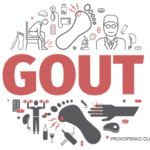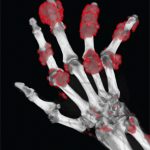PHILADELPHIA—At the first Plenary Session of ACR Convergence 2022, on Saturday, Nov. 12, speakers shared key research findings on the efficacy and safety of methotrexate as a co-therapy with pegloticase in refractory gout, the effectiveness of rituximab and cyclophosphamide in connective tissue disease associated-interstitial lung disease and the value of remote education for primary care providers in rheumatoid arthritis.
Refractory Gout
John Botson, MD, a rheumatologist in private practice in Anchorage, Alaska, reported on 12-month findings from the Methotrexate to Increase Response Rates in Patients with Uncontrolled Gout Receiving Peglogticase (MIRROR) study. Consistent with previously reported six-month findings, the new data lend greater support to adjunctive use of methotrexate as a co-therapy for patients prescribed pegloticase for refractory gout to improve both its efficacy and safety.1-3
Dr. Botson noted that patients who don’t respond well to standard, oral, uric acid-lowering agents are often very hard to treat in clinical practice. “These patients have a lot of physical disabilities; they have a lot of medical comorbidities and low quality of life and really limited treatment options,” he said.
One potential choice for such patients is pegloticase, a polyethylene glycol-conjugated (PEG) recombinant uricase approved by the U.S. Food & Drug Administration (FDA) for chronic, refractory gout.
However, Dr. Botson noted the development of anti-drug antibodies in patients often limits the use of pegloticase. “Most patients will develop [anti-drug antibodies] when [pegloticase is] given as monotherapy,” Dr. Boston said. “And these anti-drug antibodies produce a lower response rate, cause an increased risk of infusion reactions and really make it difficult for patients to complete their [treatment] course.”
MIRROR Results
Dr. Botson explained that we knew from other rheumatic diseases that concurrent treatment of methotrexate with biologic treatments does a good job of preventing the development of such anti-drug antibodies.
The double-blind, randomized, placebo-controlled MIRROR trial compared pegloticase (8 mg biweekly infusion) with placebo (n=52) and pegloticase with methotrexate (oral 15 mg/week; n =100) in patients with uncontrolled gout who had failed to improve on maximum doses of oral urate-lowering therapy.3
The trial’s primary end point was the proportion of treatment responders at month 6—defined as serum uric acid of less than 6 mg/dL for ≥80% of the time during weeks 20–24. Previously, Dr. Botson’s group had presented data demonstrating the trial met this end point, with a sustained urate-lowering response rate of 71.0% in the methotrexate group at month 6 vs. 38.5% in the placebo co-therapy group. The methotrexate group also had a lower rate of infusion reactions (4.2% vs. 30.6%).1
Discussing the newly presented findings from 12 months, Dr. Botson noted that no patient had had an infusion reaction after week 24. “You can see that the patients continued to respond,” he said. “You still have a delta of around 30%. We have about a doubling of the efficacy” (60.0% in the methotrexate co-therapy group vs. 30.8% in the placebo co-therapy group).3
Immunogenicity findings were also similar to those found at six months, indicating a lower rate of new anti-PEG antibodies in the group on methotrexate co-therapy. Grouped together, patients who did not develop anti-PEG antibodies had a better response rate and lower rate of infusion reactions than those who did. However, of those patients who did develop anti-PEG antibodies, patients on methotrexate had a better treatment response and lower rate of infusion reactions (six-month response rate 54.5% in methotrexate group vs. 25.0% in placebo); in those who did not develop such antibodies, patients on methotrexate also had a higher response rate and lower risk of infusion reaction (six-month response rate of 80.8% vs. 58.3%).1-3
Dr. Botson also shared a secondary end point in patients with gout tophi at study onset. At six months, 34.6% of those in the methotrexate-treated group had resolved at least one tophus, compared to 13.8% in the placebo group. By 12 months, 53.8% had resolved at least one tophus in the methotrexate group, with a greater than 20% improvement over patients receiving placebo co-therapy (31.0%).3
Dr. Botson noted the field has become more interested in other potential options for immunomodulation since their study was initially designed, such as mycophenolate mofetil or azathioprine.4 The researchers picked methotrexate partly because of rheumatologists’ comfort level with the drug, and they chose a moderate dose of 15 mg that most patients could tolerate, but that they hoped would provide better long-term response to pegloticase than a lower dose.
When asked how long he recommended continuing treating patients on pegloticase, Dr. Botson replied, “Have a goal in mind, whether that’s symptom relief, having no gout flares or resolution of tophi. We have data out to 52 weeks, and we show improvement … from six months to 12 months. In my mind, as long as the patient is responding and their serum uric acid is staying down and they are not having flares, you can continue until you reach that end point.”
Interstitial Lung Disease
In another section of the Plenary Session, Toby Maher, MB, MSc, PhD, a professor of clinical medicine, the University of Southern California, Los Angeles, discussed the results of the RECITAL trial: Rituximab vs. Cyclophosphamide for the Treatment of Connective Tissue Disease-Associated Interstitial Lung Disease (CTD-ILD). Although the trial failed to demonstrate the superiority of rituximab over cyclophosphamide, both treatments improved forced vital capacity (FVC), other disease characteristics and patient quality of life.5
Although biologic therapies have led to significant improvements in the management of connective tissues diseases over the past 20 years, treating the complication of ILD is remains challenging. CTD-ILD carries a significant risk of morbidity and mortality. The FDA has not approved any treatments for CTD-ILD.5
Little prospective data are available on different treatment options. Many clinicians have defaulted to cyclophosphamide as the first-line treatment for severe or progressive CTD-ILD because it had the most prospective evidence.6 However, Dr. Maher noted that cyclophosphamide is often poorly tolerated, and it also carries risks, such as bladder cancer and infertility. Over the past few years, evidence has grown to support the potential use of rituximab in patients with CTD-ILD. Many clinicians now employ it off label as rescue therapy in treatment-refractory CTD-ILD.7
RECITAL Results
The RECITAL trial, the first randomized controlled trial to assess rituximab in patients with various CTD-ILDs, was performed when Dr. Maher was with the Royal Brompton Hospital and Imperial College, London. The double-blind, double-dummy, phase 2B basket trial analyzed patients with severe or progressive ILD due to idiopathic inflammatory myositis, systemic sclerosis or mixed connective tissue disease who were appropriate candidates for cyclophosphamide therapy.5
The researchers assigned 51 patients to the rituximab group (1,000 mg intravenously at weeks 0 and 2) and 50 to the cyclophosphamide group (600 mg/m² body surface area intravenously every four weeks). Patients who had previously received cyclophosphamide or rituximab were excluded, as were any receiving any other immunosuppressants (other than oral corticosteroids) within two weeks of starting the trial.
At 24 weeks, the study drugs were stopped, and the local treating physician prescribed whatever treatment was deemed appropriate (e.g., mycophenolate mofetil, rituximab). Notably, another dose of rituximab was not necessarily given at six months, as might now be commonly done in clinical practice.
At the American Thoracic Society International Conference earlier this year, Dr. Maher’s group presented primary end point data comparing the FVC of the two groups at 24 weeks. Explained Dr. Maher, “If anything, there was a slight treatment advantage of cyclophosphamide, and that was preserved through to 48 weeks. Overall, by week 48 we saw about a 5% improvement in FVC in the cyclophosphamide group and approximately a 4% improvement compared to baseline in the rituximab group, suggesting almost certainly that both drugs had a positive benefit in this patient group.”
Dr. Maher also shared additional newly released analyses. “We saw improvements in other secondary measures, such as DLCO [diffusing capacity of carbon monoxide]; we saw improvements in quality-of-life measures and also global disease activity scores. We saw similar improvements in both groups,” he said.
Dr. Maher noted that the rituximab arm had fewer adverse events compared to cyclophosphamide—particularly gastrointestinal disorders, such as nausea, headaches and number of infusion reactions.
Although not directly related to lung function, the team also found that rituximab led to improved skin thickness, as measured by the modified Rodnan skin score (decrease in 3.4 units); whereas, patients treated with cyclophosphamide showed a slight worsening in skin thickness. Dr. Maher pointed out that these results are in line with recent results from the DESIRES trial, which also showed a benefit in skin thickening from rituximab.8
“Both cyclophosphamide and rituximab led to FVC and quality-of-life improvements in a whole range of patients with CTD-associated ILD. My take home from this is that rituximab should be considered as an alternative to cyclophosphamide in [these patients],” said Dr. Maher.
However, questions remain about the optimal use of these drugs in a clinical setting, including how they might be used with other therapies. Dr. Maher shared, “I think if I were treating some of these patients in clinical practice, I would start them with up-front rituximab and mycophenolate, but because we were making a comparison with cyclophosphamide, we didn’t feel we could build in the mycophenolate component [in the study design]. So there are some additional questions that need answering.”
RAE Initiative Enhances Rheumatology Care on Navajo Nation
Another presenter, Jennifer Mandal, MD, an assistant professor of medicine, the University of California, San Francisco, and director of the Rheumatology Access Expansion (RAE ) Initiative, discussed some of the positive impacts of a virtual education program on primary care provider education in rheumatoid arthritis.
The ACR’s most recent workforce study estimated that the demand for rheumatology providers will more than double the supply by the year 2030.9 This shortage is particularly pronounced in many non-urban areas, and additional ethnic and racial disparities also pose barriers to specialist access.
One example is the Navajo Nation, the largest Indian reservation in the U.S., home to roughly 174,000 resident tribal members across an area five times the size of Connecticut. Dr. Mandal pointed out that only one, full-time, on-site, clinical rheumatologist covers the reservation and that if one fairly redistributed current rheumatology providers across the country, it should have 19 such providers.
Many patients on the reservation must wait longer than six months and travel more than a hundred miles to see a specialist, and many are managed by primary care providers instead. Yet previous research has shown that many primary care providers feel uncomfortable managing rheumatoid arthritis with disease-modifying anti-rheumatic drugs, and patients getting care from such providers are less likely to receive appropriate therapy.10
This disparity is worsened by the fact that the prevalence of rheumatoid arthritis in the Navajo population is about five times the national prevalence, in line with other studies that have shown an increased prevalence in different American Indian tribes. This increased incidence may be due to higher frequency of certain HLA alleles and/or other unknown genetic and environmental factors. American Indian rheumatoid arthritis patients also often present with early onset disease, and they tend to have more severe disease features.11
RAE Initiative Design
After talking to Navajo community members and doing a structured needs assessment, Dr. Mandal and colleagues opted to implement one-hour weekly training sessions to teach primary care providers about the diagnosis and management of rheumatoid arthritis. Over 12 weeks, the researchers deployed live, interactive, didactic and case-based training, using a well-established educational model based on Project ECHO (Extension for Community Healthcare Outcomes), first developed at the University of New Mexico to expand primary care provider education on hepatitis C.12
Explained Dr. Mandal, “[The model] allows a small group of specialists to train primary care providers remotely using a series of live, interactive webinars. Then these primary care providers are equipped with the skills and knowledge they need to provide better specialized care to their patients.”
Dr. Mandal noted that the RAE’s inclusion of Navajo cultural interpreters in both the teaching and curriculum development process was critical. For example, the researchers learned that about one in four homes on the Navajo reservation lack electricity, making it difficult to refrigerate a biologic drug. Moreover, regular laboratory monitoring—for a drug like methotrexate, for example—is challenging for some patients, especially during winter months when the roads may be impassable.
“These are very important considerations for [primary care providers] to take into account when they consider what medications are best for their patients with rheumatoid arthritis,” said Dr. Mandal.
To date, 30 primary care providers have completed the course. When assessed via a Likert scale of 1 (not at all useful) to 5 (extremely useful), the mean usefulness rating across all sessions was 4.62. Moreover, physicians’ self-reported confidence in treating rheumatoid arthritis improved after the sessions, as did their performance on knowledge assessments on the diagnosis and management of rheumatoid arthritis.
Moving forward, Dr. Mandal and colleagues plan to expand their outreach to additional Native American communities, starting in January 2023. They are also exploring the creation of similar ECHO training for the Navajo Nations covering spondyloarthritis, another condition of increased prevalence in this population.
Ultimately, the team would also like to gather patient outcome data to better understand the impact of rheumatoid arthritis on the Navajo Nation and find areas for intervention.
Dr. Mandal noted that many community members deeply mistrust requests for private health information, based on centuries of unfair treatment and exploitation. “Asking for private health information before establishing a long track record of trust, even if it is well-intentioned, can lead to harm,” she said. “We are also focusing on continuing to build a legacy of trust and longevity in the Navajo community, so that in the future we can ethically ask for patient outcome data.
“We believe the RAE Initiative’s remote rheumatology training program is an example of an effective, low-cost and scalable model that we hope might serve as a blueprint to develop similar programs to support other vulnerable communities and ultimately reduce disparities in rheumatology care,” she concluded.
Ruth Jessen Hickman, MD, is a graduate of the Indiana University School of Medicine. She is a freelance medical and science writer living in Bloomington, Ind.
References
1. Botson J, Saag K, Peterson J, et al. OP0171 A randomized, double blind, placebo controlled, multicenter, study of methotrexate combined with pegloticase in patients with uncontrolled gout. Ann Rheum Dis. 2022;81(suppl 1):112–113.
2. Xin Y, Song Y, Weinblatt ME, et al. POS1163 Pharmacokinetics of pegloticase and methotrexate polyglutamate(s) in patients with uncontrolled gout receiving pegloticase and co-treatment with methotrexate. Ann Rheum Dis. 2022;81(suppl 1):910.
3. Botson J, Saag K, Peterson J, et al. 12-month findings of the randomized, double-blind, placebo-controlled, multicenter, efficacy and safety study of methotrexate to increase response rates in patients with uncontrolled gout receiving pegloticase (MIRROR RCT) [abstract]. Arthritis Rheumatol. 2022;74 (suppl 9).
4. Keenan RT, Botson JK, Masri KR, et al. The effect of immunomodulators on the efficacy and tolerability of pegloticase : A systematic review. Semin Arthritis Rheum. 2021 Apr;51(2):347–352.
5. Maher TM, Tudor VA, Saunders P, et al. Rituximab versus intravenous cyclophosphamide in patients with connective tissue disease-associated interstitial lung disease in the UK (RECITAL): A double-blind, double-dummy, randomised, controlled, phase 2b trial. Lancet Respir Med. 2022 Nov 11;S2213–2600(22):00359-9.
6. Tashkin DP, Elashoff R, Clements PJ, et al. Cyclophosphamide versus placebo in scleroderma lung disease. N Engl J Med. 2006 Jun 22;354(25):2655–2666.
7. Keir GJ, Maher TM, Ming D, et al. Rituximab in severe, treatment-refractory interstitial lung disease. Respirology. 2014 Apr;19(3):353–359.
8. Ebata S, Yoshizaki A, Oba K. Safety and efficacy of rituximab in systemic sclerosis (DESIRES): A double-blind, investigator-initiated, randomized, placebo-controlled trial. Lancet Rheumatol. 2021 Jul;3(7):E489–E497.
9. Battafarano DF, Ditmyer M, Bolster MB, et al. 2015 American College of Rheumatology workforce study: Supply and demand projections of adult rheumatology workforce, 2015–2030. Arthritis Care Res (Hoboken). 2018 Apr;70(4):617–626.
10. Garneau KL, Iversen MD, Tsao H, et al. Primary care physicians’ perspectives towards managing rheumatoid arthritis: Room for improvement. Arthritis Res Ther. 2011;13(6):R189.
11. Ferucci ED, Templin DW, Lanier AP. Rheumatoid arthritis in American Indians and Alaska Natives: A review of the literature. Semin Arthritis Rheum. 2005 Feb;34(4):662–667.
12. Arora S, Thornton K, Komaromy M. Demonopolizing medical knowledge. Acad Med. 2014 Jan;89(1):30–32.






